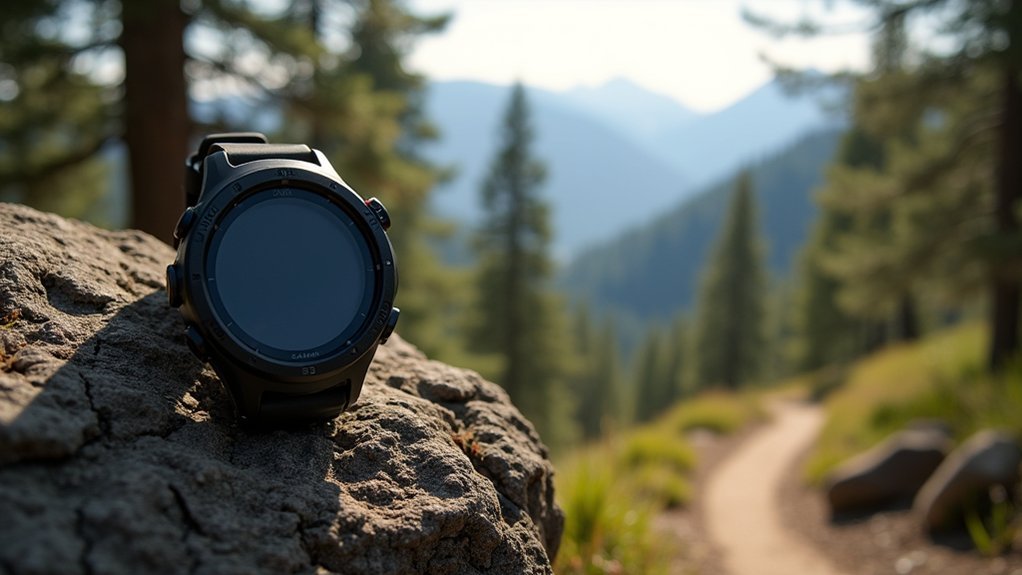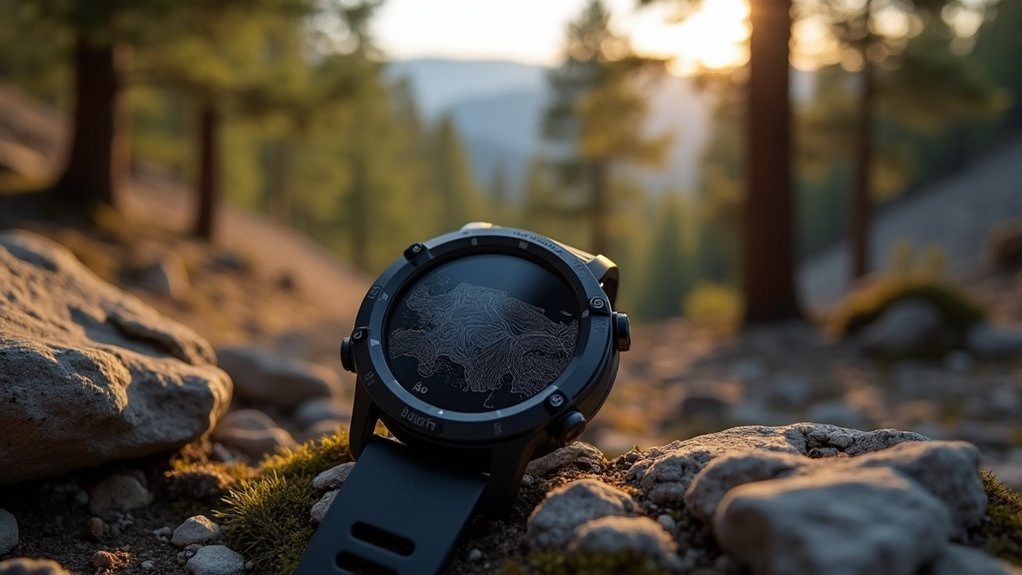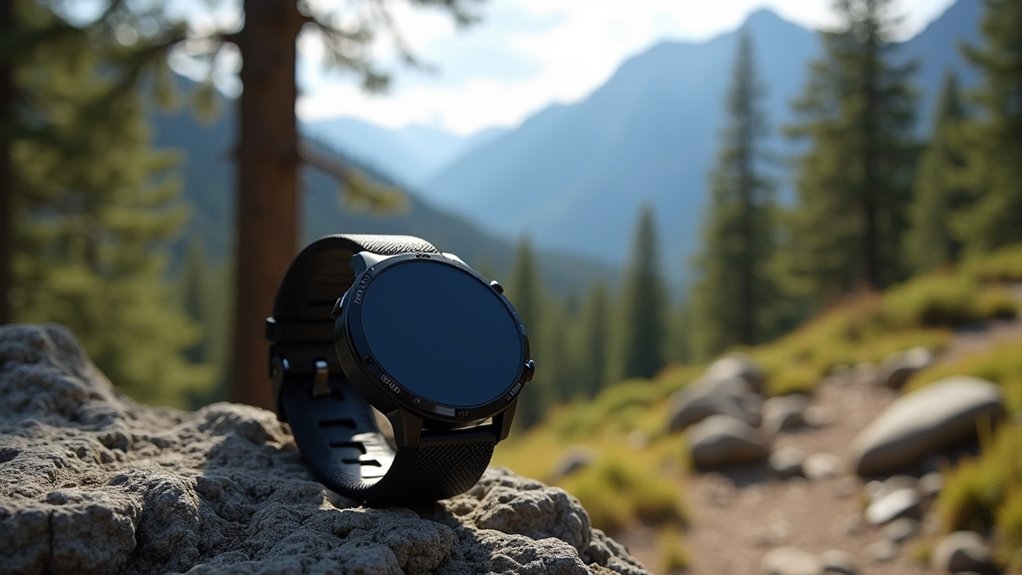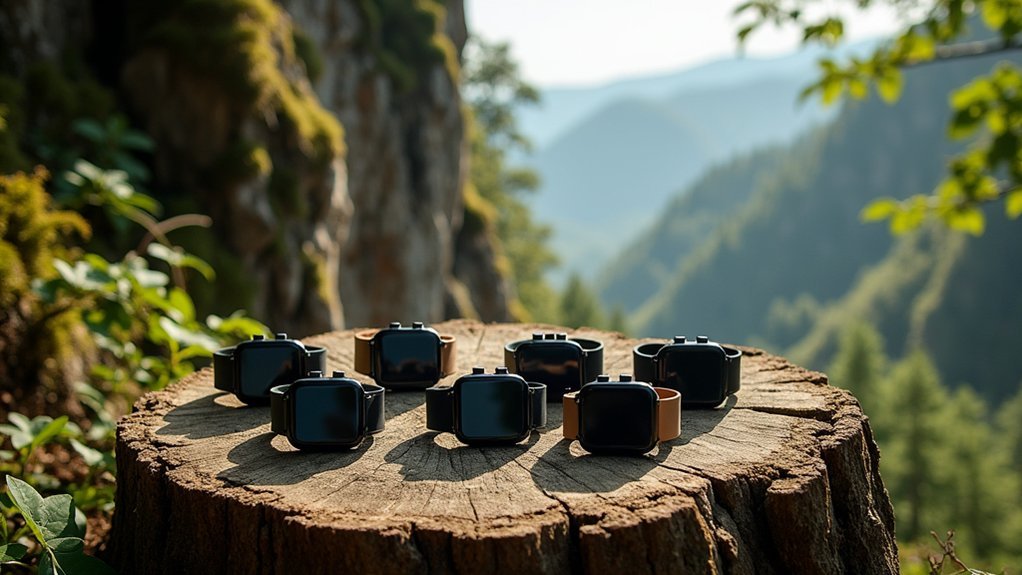For wilderness adventures, you’ll want Garmin’s multi-satellite system for deep canyon navigation, Coros Vertix with its impressive 60-day battery life, Suunto’s detailed topographic maps with three viewing styles, and Apple Watch Ultra 2 with third-party apps like WorkOutdoors. Look for watches supporting multiple satellite systems (GPS, GLONASS, Galileo), offline mapping capabilities, and multi-day battery performance. The right navigation watch could make the difference between staying on course and getting lost in the backcountry.
Garmin’s Multi-Satellite Navigation System for Remote Trails

Explorers venturing into the wilderness need reliable navigation, and Garmin’s Multi-Satellite Navigation System delivers precisely that.
By utilizing multi-band GNSS technology, your device simultaneously connects to GPS, GLONASS, and Galileo satellites, ensuring accurate positioning even in challenging environments like dense forests or deep canyons.
You’ll benefit from impressive storage capacity with up to 5000 waypoints, 200 routes, and 10,000 track points at your disposal.
When traditional GPS falters, Garmin’s multi-satellite reception provides faster location fixes and improved course accuracy—crucial for wilderness safety.
The system integrates seamlessly with offline topographic maps, showing trails, elevation contours, and water sources when you’re far from cell service. While OutdoorGearLab reviews are temporarily unavailable due to planned maintenance, their detailed analyses typically highlight this feature’s reliability in remote settings.
Simply pre-plan your adventure and wirelessly transfer everything to your device via Bluetooth.
Coros Vertix: Extended Battery Life for Multi-Day Mapping
For endurance adventurers, the Coros Vertix stands as a revolutionary force in wilderness guiding. Its exceptional 60-day battery life drains merely 3% per day during normal training, eliminating the need for power-saving modes or frequent charging during multi-day expeditions.
The watch’s offline mapping capabilities shine with three distinct map options you can download directly from Coros:
- Topographic maps – Essential for guiding elevation changes in remote terrain
- Landscape maps – Perfect for faster-paced activities with street information
- Hybrid maps – Thorough view combining the best of both styles
- High-resolution visuals – Superior clarity compared to competitors
You’ll appreciate the dual-frequency GPS accuracy while guiding signal-free zones, making the Vertix an indispensable tool for serious wilderness adventures. The watch’s sapphire glass screen provides exceptional durability for protecting your maps and data during rugged outdoor expeditions.
Suunto’s Topographic Precision in Signal-Free Zones

While Coros Vertix dominates the battery life competition, Suunto watches excel with their remarkable offline topographic precision.
The Vertical model offers detailed global topographic maps without additional charges, featuring shading and three distinct styles: Outdoor (default orange), High Contrast, and Dark Mode.
You’ll appreciate the terrain recognition capabilities when exploring unfamiliar wilderness areas. Though not routable on the watch itself, you can pre-plan routes via the Suunto App and sync them for offline guidance.
The maps display contour lines and specific terrain features essential for safe navigation in remote environments. With 32GB of storage, you can download multiple regional maps for extended cross-country expeditions.
For maximum efficiency, toggle between map styles to adapt to changing lighting conditions.
Remember to download your maps via Wi-Fi while the watch charges before heading into signal-free zones.
Apple Watch Ultra 2: Third-Party Solutions for Day Hikes
The Apple Watch Ultra 2 transforms into a capable wilderness navigation tool through specialized third-party applications.
Apps like WorkOutdoors enable offline topographic maps with customizable contour lines, vastly expanding the watch’s native capabilities. You’ll appreciate the ability to import GPX files from familiar platforms like Garmin or Strava directly to your wrist. Unlike third-party solutions, Apple’s native Maps app allows you to sync offline maps for use when your iPhone isn’t nearby.
- Enhanced GPS precision – Multi-band GNSS support guarantees reliable positioning even in challenging terrain
- Complete offline functionality – Access maps and navigation without your iPhone nearby
- Real-time metrics – Track distance, elevation and receive alerts while following clear route markers
- Practical limitations – Touchscreen controls can be frustrating with gloves or when fatigued compared to traditional button-based GPS devices
Essential Features for Reliable Wilderness Watch Navigation

Moving beyond third-party solutions, successful wilderness navigation hinges on specific smartwatch capabilities that can truly replace traditional GPS devices. Your watch should support multiple satellite systems (GPS, GLONASS, Galileo) for reliable tracking in remote areas where reception can be spotty.
Look for devices with detailed topographic maps, compass functionality, and waypoint markers to help you navigate challenging terrain. A watch with OS grid reference capability guarantees you can precisely communicate your location during emergencies. Models like the Garmin fenix 7X offer exceptional navigation features with remarkable battery life.
Proper navigation tools—topo maps, compass, waypoints, and grid references—transform a smartwatch from timepiece to wilderness lifeline.
Battery life is non-negotiable—your device should last multiple days without charging. Critical safety features include barometer readings for weather prediction and offline functionality that doesn’t require internet connectivity.
For high-altitude adventures, consider watches with SpO2 monitoring to track your oxygen levels as elevation changes.
Frequently Asked Questions
Can Offline Maps Work Without Initial Setup in Cellular Coverage Areas?
No, you can’t use offline maps without initial setup in cellular coverage. You must download maps while connected to cellular or Wi-Fi before they’ll work in areas without service.
How Much Storage Space Do Topographic Maps Typically Require?
Topographic maps typically require 1.7-68.7 MB per map, averaging 11.4 MB each. You’ll need to plan for this storage space, as a complete regional collection could consume dozens of gigabytes on your device.
Are Wilderness Watch Maps Accurate Enough for Technical Mountaineering Routes?
Watch maps provide decent accuracy but aren’t always sufficient for technical mountaineering routes. You’ll need additional navigation tools and skills for complex terrain. Consider them helpful supplements rather than standalone solutions.
Can Offline Maps Alert You About Dangerous Terrain Ahead?
Yes, offline maps can alert you about dangerous terrain ahead through pre-loaded data showing steep slopes, difficult sections, and elevation changes. You’ll need to interpret contour lines and topographic features since real-time hazard updates aren’t available.
Do Smartwatches Offer Custom Waypoint Creation on Offline Maps?
Yes, many smartwatches support custom waypoint creation on offline maps. You’ll find this feature particularly in Garmin devices with Explore app and through third-party apps like BackCountry Navigator and onX Backcountry.
In Summary
When you’re venturing into signal-free wilderness, the right offline smartwatch map becomes your lifeline. Whether you’re choosing Garmin’s multi-satellite precision, Coros’s battery endurance, Suunto’s topographic detail, or Apple’s third-party solutions, prioritize battery life, durability, and easy-to-read displays. You’ll never need to worry about losing your way again, even in the most remote locations. Your adventure awaits—now with added confidence and safety.





Leave a Reply